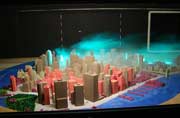Fine-Scale Modeling
Research Programs
The purpose of this research is to develop and evaluate numerical and physical modeling tools for simulating ambient concentrations of airborne substances in urban settings at spatial scales ranging from <1-10 km. This research will support client needs in human exposure modeling of air toxics and for homeland security.
The research is organized into four areas: (1) development on an initial prototype to support human exposure modeling; (2) development of a second-generation human exposure support tool; (3) development of an advanced human exposure support tool; and (4) urban-scale modeling to support Homeland Security. Development of tools under this task will help bridge the modeling gap that current exists between Eulerian chemical grid models and traditional Gaussian plume dispersion models, with a goal of more accurately modeling the temporal and spatial variability of ground-level concentrations of airborne substances that occur in urban settings. With the development of improved community-scale modeling tools, assessments of exposure to air toxics and hazardous releases can be improved.
Fine Scale Modeling
Philadephia Modeling Prototype (PDF, 19 pp, 490KB)About PDF
World Trade Center Disaster Site![[logo] US EPA](https://webarchive.library.unt.edu/eot2008/20081109145011im_/http://www.epa.gov/epafiles/images/logo_epaseal.gif)
